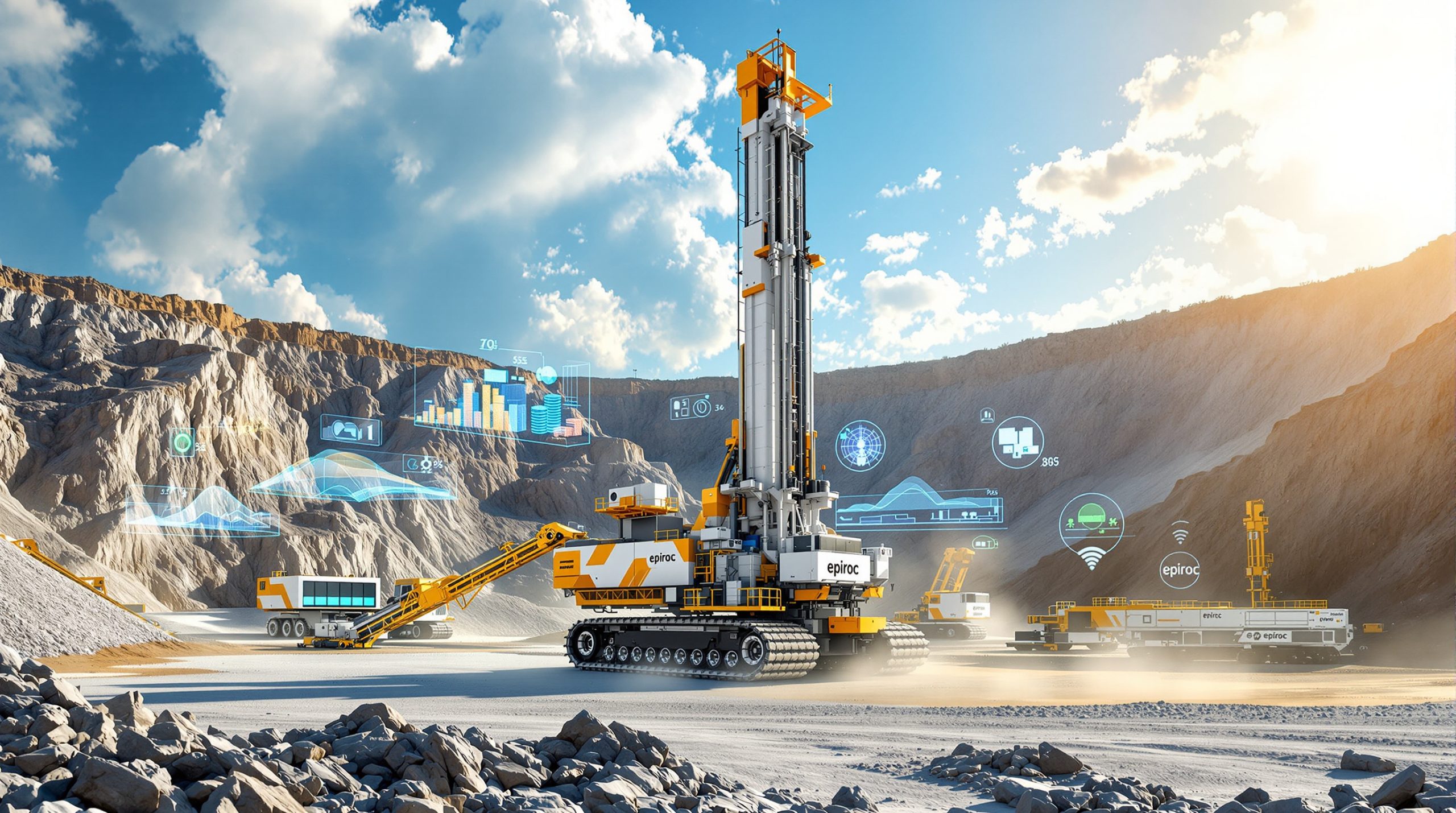Why Is Tharisa Transitioning from Open-Pit to Underground Mining?
The Tharisa Mine underground transition represents a strategic shift driven by both operational necessities and long-term value creation objectives. This transformation addresses multiple converging factors that make underground mining engineering the optimal path forward for sustained operations.
Strategic Drivers Behind the Mining Method Shift
Market dynamics and resource optimisation requirements have created compelling reasons for Tharisa's operational evolution. The transition addresses the natural progression from surface mining to accessing deeper, potentially higher-grade ore bodies that remain economically viable for extraction.
The company's approach reflects broader industry pressures demanding enhanced operational efficiency and cost optimisation. As surface reserves in easily accessible areas become depleted, mining companies must adapt their extraction methods to maintain production levels and economic viability.
Furthermore, the mining industry evolution demonstrates that long-term sustainability considerations play a crucial role in this decision. Underground operations can provide more selective mining capabilities, allowing for better grade control and resource utilisation compared to open-pit methods that may require removing larger volumes of waste rock.
Financial Justification for the $547 Million Investment
The substantial capital commitment of $547 million for the Tharisa Mine underground transition demonstrates the company's confidence in the project's long-term returns. This investment is designed to extend mining operations significantly beyond the current mine life projections.
According to company statements, the underground development will add more than 40 additional years to the mine's operational lifespan, extending potential production well beyond 2041. This extension provides substantial value creation opportunities and justifies the significant upfront capital expenditure.
The mechanised underground approach promises enhanced productivity through advanced mining technologies and methods. These improvements are expected to deliver operational efficiencies that can offset the higher initial investment costs over the extended mine life.
Environmental considerations also support the financial case, as underground operations typically have a smaller surface footprint compared to expanding open-pit operations. This approach can reduce environmental compliance costs and community impact mitigation expenses.
What Are the Key Technical Specifications of Tharisa's Underground Project?
The Tharisa Mine underground transition incorporates advanced mining technologies and methodologies designed to maximise efficiency and safety whilst ensuring sustainable long-term operations.
Mining Method and Infrastructure Development
| Parameter | Specification | Timeline |
|---|---|---|
| Total Investment | $547 million | 2025-2035 |
| West Pit Steady State | Production optimisation | By FY2029 |
| East Pit Portal | Secondary access development | By FY2033 |
| Mine Life Extension | 40+ additional years | Beyond 2041 |
| Mining Method | Mechanised underground | Phased implementation |
The technical approach centres on mechanised underground mining operations that will be implemented through a carefully planned phased development strategy. This method allows for operational continuity whilst gradually transitioning from surface to underground extraction.
Infrastructure development focuses on establishing robust access points and support systems necessary for safe and efficient underground operations. The dual-portal approach provides operational flexibility and enhanced safety through multiple egress routes.
Technological Innovations in Underground Operations
Modern underground mining operations increasingly rely on advanced technologies to improve safety, efficiency, and environmental performance. However, AI in mining operations is becoming integral to these technological implementations.
Battery-electric vehicles are becoming standard in underground operations due to their reduced ventilation requirements and lower operating costs compared to diesel equipment. These systems can significantly improve air quality in underground workings whilst reducing energy consumption.
Advanced monitoring systems for ground stability and geological conditions are essential for safe underground operations. In addition, real-time data collection and analysis help optimise mining sequences and ensure worker safety in dynamic underground environments.
Automated ore handling and transportation systems can improve efficiency and reduce manual handling requirements in underground settings. These systems integrate with surface processing facilities to maintain production continuity throughout the transition period.
How Will the Phased Implementation Timeline Unfold?
The strategic implementation approach for the Tharisa Mine underground transition follows a carefully structured timeline designed to minimise operational disruption whilst maximising learning opportunities and risk mitigation.
Phase 1: West Pit Portal Development (2025-2029)
The initial phase focuses on establishing underground access through the western pit area, with target completion and steady-state production by FY2029. This timeline provides approximately four years for infrastructure development, equipment installation, and operational optimisation.
Key activities during this phase include:
- Underground access development and primary infrastructure installation
- Safety systems integration and comprehensive workforce training programmes
- Gradual production ramp-up to establish operational procedures and optimise performance
- Equipment commissioning and process optimisation to achieve steady-state operations
The western portal serves as the primary learning environment where operational procedures are refined and best practices established before expanding to the second phase. This approach allows for real-world testing and optimisation of underground mining methods specific to Tharisa's geological conditions.
Phase 2: East Pit Portal Expansion (2029-2033)
The second phase involves developing the eastern portal access point, scheduled for completion by FY2033. This expansion builds upon the operational experience and lessons learned from the western portal development.
Phase 2 activities encompass:
- Secondary access point establishment providing operational redundancy and increased capacity
- Full-scale mechanised mining implementation across both portal areas
- Production capacity optimisation to achieve target output levels
- Operational integration between both underground access points and surface facilities
The dual-portal approach provides operational flexibility and enhanced safety through multiple access routes. This configuration also allows for more efficient ore extraction and transportation whilst providing backup options in case of equipment maintenance or operational challenges.
What Production Targets Define Success for the Underground Operation?
Success metrics for the Tharisa Mine underground transition are defined through specific production targets that demonstrate operational effectiveness and financial viability of the substantial capital investment.
Short-term Production Milestones (FY2026)
The company has established clear production guidance for FY2026 that serves as an interim benchmark during the transition period:
Key Performance Indicators:
- PGM production target: 145,000-165,000 ounces (6E)
- Chrome concentrate output: 1.50-1.65 million tonnes
- Safety performance maintenance with LTIFR targets below 0.05
- Operational cost optimisation through efficiency improvements
These targets represent growth from FY2025 actual results, where Tharisa achieved 138,300 ounces of PGM production and 1.56 million tonnes of chrome concentrate output. The FY2026 guidance indicates expected production increases of approximately 5-19% for PGMs and maintenance of chrome production levels.
Recent quarterly performance supports these projections, with Q4 FY2025 showing strong momentum. PGM production reached 41,300 ounces in the final quarter, representing a 19.7% increase quarter-on-quarter from 34,500 ounces in Q3. Chrome production achieved 407,200 tonnes in Q4, with a 2.9% quarterly increase.
Long-term Production Projections (2033+)
Long-term success metrics focus on achieving sustainable production levels that justify the underground transition investment:
- Annual PGM production exceeding 200,000 ounces by 2033
- Sustained chrome concentrate volumes maintaining current levels above 1.5 million tonnes annually
- Enhanced recovery rates through selective underground mining methods
- Improved product quality and grade consistency from targeted extraction
The extended mine life of 40+ additional years provides the operational timeline necessary to achieve these production targets whilst generating returns on the $547 million investment. This extended operational period allows for production optimisation and technology implementation that can improve efficiency over time.
How Does Underground Mining Address Tharisa's Sustainability Goals?
The transition to underground mining operations aligns with broader sustainability objectives whilst supporting long-term operational viability and community benefits through sustainable mining practices.
Environmental Benefits of the Transition
Underground mining typically offers several environmental advantages compared to expanding open-pit operations. The reduced surface disturbance allows for preservation of larger land areas and minimises the visual impact of mining operations on surrounding communities.
Water management systems in underground operations can be designed with closed-loop configurations that reduce overall water consumption and improve water quality control. These systems can minimise the environmental impact on local water resources whilst maintaining operational efficiency.
Air quality improvements result from reduced dust generation compared to large-scale surface mining operations. Underground operations contain dust within controlled ventilation systems, reducing atmospheric emissions and improving air quality for nearby communities.
Social and Economic Impact Considerations
The extended mine life projection of 40+ additional years provides significant community benefits through sustained employment opportunities and regional economic stability. This longevity supports multi-generational employment and career development for local workers.
Workforce development through underground mining training creates valuable skills that are transferable within the broader mining industry. These specialised capabilities enhance employment prospects and career advancement opportunities for the local workforce.
As Tharisa's transition plan demonstrates, Phoevos Pouroulis, CEO of Tharisa, emphasised that the investment demonstrates commitment to unlocking the mine's multi-generational potential whilst maintaining safety, sustainability, and efficiency.
Regional economic impact extends beyond direct employment to supporting service industries, suppliers, and community infrastructure development. The sustained mining operations provide economic stability that supports broader regional development initiatives.
What Geological Challenges Must Be Overcome?
Underground mining operations at Tharisa face several geological and technical challenges that require sophisticated solutions and continuous monitoring systems.
Complex Geological Structure Management
The transition from open-pit to underground mining requires detailed understanding of subsurface geological conditions, including structural geology, ore body geometry, and geotechnical characteristics of the rock mass.
Multi-layered reef systems common in platinum group metal deposits require selective extraction methods that can efficiently separate ore-bearing zones from waste rock. This selectivity is crucial for maintaining grade control and operational efficiency in underground environments.
Variable ore grade distribution across different underground zones necessitates flexible mining sequences and real-time grade control systems. Recent performance improvements, including enhanced PGM grades and recoveries in Q4 FY2025, demonstrate successful geological management in current operations.
Ground stability considerations become increasingly important as mining moves to greater depths. Rock mechanics analysis and ongoing monitoring are essential for maintaining safe working conditions and preventing ground instability events.
Technical Solutions for Geological Complexity
Advanced geological modelling and resource evaluation systems provide the foundation for effective underground mine planning and operation. These systems integrate surface exploration data with underground development information to optimise extraction sequences.
Flexible mining sequences that can adapt to ore body geometry and geological conditions allow for responsive operational adjustments. This adaptability is crucial for maintaining production efficiency whilst managing geological uncertainties.
Continuous monitoring systems provide real-time data on ground conditions, ore grades, and operational parameters. Furthermore, data-driven mining operations support adaptive management strategies that can respond quickly to changing geological conditions.
Integration between surface and underground operations requires careful coordination to maintain production continuity during the transition period. This integration includes ore handling systems, processing logistics, and workforce management across both operational areas.
How Will This Impact Tharisa's Market Position?
The underground transition positions Tharisa for enhanced competitiveness and improved long-term market positioning within the platinum group metals and chrome sectors.
Competitive Advantages Through Underground Operations
Enhanced operational flexibility during market volatility represents a significant competitive advantage. Underground operations can often adjust production levels more efficiently than large-scale open-pit operations, allowing for better response to commodity price fluctuations.
The company's strong financial position supports this transition, with cash on hand of $173 million and total debt of $104.4 million, resulting in a net cash position of $68.6 million at year-end. This represents an improvement from $43.1 million net cash in June 2025.
Recent market performance demonstrates the value of operational flexibility. Q4 FY2025 average PGM basket prices climbed to $1,953 per ounce, representing a 24% increase from the previous quarter. The full-year average reached $1,615 per ounce, whilst chrome concentrate prices averaged $266 per tonne.
Extended resource base supporting long-term contracts provides stability in customer relationships and revenue predictability. The 40+ year mine life extension enables longer-term supply agreements that can provide pricing advantages and market security.
Financial Performance Implications
Expected Financial Benefits:
- Reduced unit operating costs through mechanisation and efficiency improvements
- Enhanced revenue stability through extended operational timeline
- Improved cash flow predictability from long-term production visibility
- Strengthened balance sheet through asset optimisation and extended asset life
The substantial $547 million investment represents one of the largest mining method conversions in the South African PGM sector, demonstrating Tharisa's commitment to long-term operational sustainability and competitive positioning.
Production guidance for FY2026 of 145,000-165,000 ounces PGMs and 1.50-1.65 million tonnes chrome concentrates is supported by stable demand fundamentals and improved operational flexibility resulting from the ongoing transition.
What Are the Key Risk Factors and Mitigation Strategies?
The underground transition involves several operational, technical, and financial risks that require comprehensive mitigation strategies to ensure project success.
Technical and Operational Risks
Underground mining complexity presents learning curve challenges as the workforce and management adapt to different operational requirements compared to open-pit mining. This transition requires substantial training and operational procedure development.
Equipment reliability in underground environments differs significantly from surface operations, requiring specialised maintenance procedures and backup systems to minimise production interruptions.
Workforce adaptation to new mining methods involves comprehensive training programmes and safety protocol adjustments. The company's strong safety record, including a Lost Time Injury Frequency Rate (LTIFR) of 0.03 at Tharisa Minerals operations and 0.00 at Karo Platinum, provides a foundation for safe underground operations.
Integration challenges between surface and underground operations require careful coordination to maintain production continuity during the transition period. This includes ore handling logistics, processing coordination, and resource allocation between both operational areas.
Risk Mitigation Approaches
Phased implementation strategy reduces operational disruption by allowing gradual transition and learning opportunities. The timeline extending from west pit development (steady state by FY2029) to east pit portal completion (by FY2033) provides adequate time for operational optimisation.
Comprehensive training programmes support workforce development and ensure safe transition to underground operations. The company's demonstrated commitment to safety performance provides a strong foundation for this training initiative.
Consequently, proven technology adoption from industry best practices reduces technical risks by implementing established underground mining methods rather than experimental approaches. This strategy balances innovation with operational reliability.
Continuous monitoring and adaptive management systems provide real-time operational feedback that enables quick response to operational challenges or changing conditions.
How Does This Align with Global Mining Industry Trends?
Tharisa's underground transition reflects broader industry movements toward sustainable, technology-enhanced mining operations that prioritise long-term value creation and environmental responsibility.
Industry-Wide Shift Toward Underground Operations
The global mining industry increasingly recognises underground mining as a pathway to accessing deeper, higher-grade ore bodies whilst minimising surface environmental impact. This trend is particularly evident in mature mining regions where surface deposits have been extensively exploited.
Mechanised underground mining adoption has accelerated due to technological improvements in equipment reliability, automation capabilities, and safety systems. These advances make underground operations more economically viable and operationally efficient than in previous decades.
Focus on operational efficiency and sustainability drives mining companies to invest in technologies and methods that reduce environmental impact whilst maintaining or improving production levels. Underground operations align with these objectives through reduced surface disturbance and improved resource utilisation.
Technology integration for improved safety and productivity has become a key differentiator in modern mining operations. Advanced monitoring systems, automated equipment, and real-time data analysis contribute to safer and more efficient underground operations.
Tharisa's Position Within Industry Evolution
Tharisa's proactive approach to mining method optimisation positions the company as a leader in operational transition strategies. The substantial $547 million investment demonstrates commitment to long-term competitiveness rather than short-term profit maximisation.
Leadership in dual-commodity underground operations provides unique market positioning, as few companies successfully operate both PGM and chrome production from underground sources. This dual-commodity approach offers operational synergies and market diversification benefits.
Innovation adoption supporting competitive positioning reflects the company's commitment to implementing proven technologies whilst maintaining operational safety and efficiency. This approach balances technological advancement with operational reliability.
Moreover, according to Tharisa's underground mining development, sustainable mining practices alignment with Environmental, Social, and Governance (ESG) requirements positions Tharisa favourably for institutional investment and long-term market support.
Investment Significance
Tharisa's $547 million underground transition represents one of the largest mining method conversions in the South African PGM sector, demonstrating the company's commitment to long-term operational sustainability and resource optimisation.
The company's strong financial performance in FY2025, including a 19.7% quarter-on-quarter increase in PGM production and improved safety metrics, provides a solid foundation for executing this ambitious transition. CEO Phoevos Pouroulis emphasised that in a dynamic mining landscape, these long-term investments are essential to unlocking resource potential, enhancing productivity, and securing value for future generations.
Disclaimer: This analysis is based on publicly available information and company reports. Mining operations involve inherent risks, and actual results may vary from projections and expectations. Commodity prices, operational performance, and market conditions can impact actual outcomes. Investors should conduct their own due diligence and consult with financial advisors before making investment decisions.
Looking to Capitalise on Major Mining Transitions?
Discovery Alert's proprietary Discovery IQ model delivers real-time alerts on significant ASX mineral discoveries, instantly empowering subscribers to identify actionable opportunities ahead of the broader market. Begin your 30-day free trial today and secure your market-leading advantage in mining sector transitions and discoveries.




